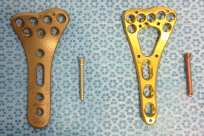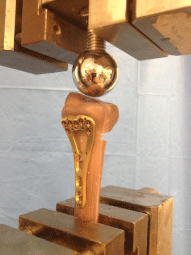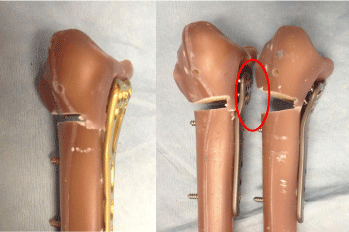Research Article
Mechanical Testing of Two Different Variable Angle Locking Systems for Treatment of Distal Radius Fractures
Tom Adler*, Thomas Schaefer and Piers Yates
Department of Orthopaedic Surgery, Fremantle Hospital and Health Service, Australia
*Corresponding author: Tom Adler, Department of Orthopaedic Surgery, Fremantle Hospital and Health Service, Western Australia
Published: 15 Feb, 2017
Cite this article as: Adler T, Schaefer T, Yates P.
Mechanical Testing of Two Different
Variable Angle Locking Systems for
Treatment of Distal Radius Fractures.
Clin Surg. 2017; 2: 1313.
Abstract
Background: In recent years, the volar locking plating of distal radius fractures has become popular.
Locking mechanisms have improved with the variable angle locking mechanism. The aim of the
study was to evaluate the different behavior of different screw plate locking mechanisms and,
furthermore, the influence on the stability in the fracture setting.
Methods: Distal radius plates Synthes VA-LCP Two-Column and Stryker VariAx were compared.
The locking mechanisms were tested as cantilever bending tests ascyclic staircase loading tests in
0° and 15° screw angulation as well as relocking in 0° angulation after locking in 15° using the
Zwick/Roell Z010 material testing machine. The stability in an extraarticular, dorsally comminuted
fracture (AO 23.A3) with Sawbones was also compared.
Findings: The Synthes plate showed a load to failure of 834.1 N for 0°, 500.2 N for 15°. The Stryker
plate showed a load to failure of 492.2 N for 0°, 202.9 N for 15°. In the relocking test a load to failure
of 372.2 N was found for the Synthes plates and 155.3 N for the Stryker plates with high significance
to 0° for both plates, no significance to 15°. In all three locking mechanism tests the difference
between the two plates was significant.
The fracture setting showed no significant difference, but different failure mechanisms.
Interpretation: Higher screw plate angulation led to less stability. Relocking does not decrease the
stability compared to 15°. Although Synthes plates were superior in the locking tests, a difference in
the fracture fixation could not be found.
Background
Distal radius fractures are the most common fracture in adults with an incidence of about
2/1000 people per year [1,8,14]. Two injury peaks exist for young male patients with high energy
injuries on one hand and for postmenopausal females due to the developing osteoporosis on the
other hand [1,2,3,14].
Based on the increased availability of locking plates during recent years, the majority of the distal
radius fractures are treated surgically nowadays. Moreover these fractures are mainly fixed with
volar plates due to the evolved locking screw mechanisms including polyaxial designs providing
stability even in dorsally comminuted fractures, combined with the less risk of complications like
extensor tendon irritation, less range of movement and even higher risk of loss of reduction [10,16].
Several plates with differing screw-plate locking mechanisms have been developed and compared
in recent studies [1,3,9,12,13,18]. However, a direct comparison between the latest polyaxial locking
systems including the Synthes® variable angle plate and the Stryker® VariAx plate has not been done
yet (Figure 1). The purpose of this study is to compare these two different variable screw locking
mechanisms using a mechanical testing setup and Sawbones®.
Materials and Methods
The required implants with the belonging instruments as well as the Sawbones® were provided
by the companies. In summary, we had 12 volar distal radius plates of each company (Synthes®
variable angle plate, 3 shaft holes, width 25.5mm; Stryker®VariAx Distal Radius Plate standard size)
and each 6 Radius Sawbones® (item # 3407, 4th generation) were provided by Synthes and Stryker
respectively. The Sawbones® were labeled and numbered and based on this randomized with the help
of the Windows Excel® random function before testing the fracture setting.
The use of Sawbones® has been validated in recent studies
[3,4,12,17,18,20,21].
As a first series, the single screw interface of each implant system
was mechanically tested in 0° as well as in 15° screw angulation
using the Zwick/Roell Z010 material testing machine in cantilever
bending pattern with a cyclic staircase loading. In addition, the same
test was performed in a 0° relocked angulation after a locking in 15°
angulation. The accuracy of the screw angulation was achieved with
the help of Synbone® foam. First, we fixed the plate preliminarily with
K wires on the foam, followed by drilling with the drill guide provided
by the companies in the angle of 0° or 15° respectively. Finally, we
applied the screw in the according angle and locked the screw in the
way the companies recommend for their system.
A 20 mm locking screw was used as a standardized lever arm to
create a bending moment in the locking interface. However, in order
to imitate the short lever arm in a fracture situation, the loading point
was located as close as possible to the plate allowing a test moving
without interference between plate and loading plate. The load was
applied perpendicularly to the screw. The plates itself were fixed with
two 30 mm long fixed angle screws on a wooden block (Figure 2).
The cyclic staircase loading test started with a load of 5 N and
increased with 5 N per cycle. The moving velocity was 0.1 mm/s. The
load was discharged when a 20 percent loss of load was recognized.
A plastic deforming of the locking mechanism or even of the screw
itself did not show such loss of load and, thus, was not recognized
by the machine. Nevertheless, this was well indicated by the position
of the screw in relation to the loading plate. The test was manually stopped when the screw was not parallel to the lower surface of the loading plate.
As a second series, we simulated a fracture situation creating
an extraarticular, dorsally comminuted fracture (AO classification
23 A3) on the Sawbones® and fixed these fractures with either the
Synthes® plate or the Stryker® plate. In order to apply the screws in the
same angle for all radii, the drill guide block was used for the Synthes®
plates and the fixed angle drill guide was used for the Stryker® plates.
A cyclic staircase loading test according to the screw plate locking
mechanism test was performed with an applied load in the scaphoid
fossa through a metal ball imitating the physiological load in the
radiocarpal joint [6] (Figure 3). Again the endpoint of the test was a
load loss of 20 percent and/or a loss of reduction of more than 2 mm.
Results
Each trial consisted of seven tests. For every trial series an
average value was calculated and with the help of the t-test all trials
were compared. First, in the screw plate locking mechanism test a
significant reduction of load to failure was recognized for both plates
when the locking in 0° and 15° was compared. The Synthes® plate
showed an average load to failure of 834.1 N (±223N) for locking in
0° angulation. For an angulation of 15°, the same plate had a load to
failure on average of 500.2 N (±166.9N). Thus the reduction of load to
failure was significant (p 0.014).
A higher decrease of load to failure was found for the Stryker® plates when the similar trails were compared. An average load
to failure was calculated with 492.2 N (±67.6N) for locking in 0°
angulation and 202.9 N (±29.4N) for locking in 15° angulation,
respectively. This difference was very significant (p< 0.001).
Secondly, comparing the results of the relocking trials, namely
locking in 15° angulation followed by relocking in 0°, with the
previous mentioned trials, a similar behavior for these two plates
could be found.
A load to failure on average of 372.2 N (±96.2N) was shown for the
Synthes® plates and 155.3 N (±57.4N) for the Stryker® plates. Therefore,
a very significant difference was seen comparing the relocking trials
with the 0° angulation trials in both plates (p< 0.001). The comparison
of the relocking trials with the trials locking in 15° angulation showed
no significant difference (p 0.104, Synthes®; p 0.075, Stryker®).
Comparing the two plates in all three screw plate locking
mechanism trials, the Synthes® plate showed a very significant higher
load to failure in all three trial (p< 0.001 for 15° and relocking, p 0.003
for 0°).
However, the comparison between the two plates in the fracture
setting demonstrated no significant difference (p 0.779) in the average
load to failure (Synthes®: 1766.6N±417.6N, Stryker®: 1716.5N±80.5N).
During the testing in the fracture setting, the type of failure
was different for both plates, moreover. Whereas the failure in the
Synthes® locking mechanism only was seen, the failure in the Stryker®
plates was due to the failure of the locking mechanism itself as well as
bending of all plates in the fracture zone occurred during the fracture
setting tests (Figures 4 and 5).
Figure 1
Figure 2
Figure 3
Figure 4 and 5
Figure 4 and 5
Loss of reduction without bending of the plate on the
left Synthes® plate; bending of the Stryker® plate.
Discussion
In the last years, the palmar plating of distal radius fractures has
become very popular based on the new design of the plates itself.
Especially the development of locking plates has led to a major use
of palmar plates. Recently, the locking mechanisms were improved
with the variable angle locking mechanism. Different companies
developed different designs [10,16].
The aim of the study was to evaluate the different behavior
of different screw plate locking mechanisms for variable angle
locking and, furthermore, the influence of the different behavior
on the stability in the fracture setting of an extraarticular dorsally
comminuted distal radius fracture.
As Synthes® as well as Stryker® are the main companies supplying
our department with implants, we chose their locking mechanisms
(“Discontinuous thread” - Synthes®, “Ti II/V” - Stryker®) to be
evaluated. The inclusion of the “TriLock” mechanism of Medartis® in
the study failed due to rejection of the company taking part in the
study.
Similar behavior between the two plates was found in regard to
the screw plate angulation. The highest resistance against failure of
the locking mechanism for both plates could be demonstrated in the
neutral position. Whereas a significant less load to failure was needed
in 15° angulation in both plates compared to the neutral position, the
difference between locking in 15° of angulation and relocking in 15°
angulation after locking in neutral angulation was not significant. The
influence of an increased locking screw angulation with following loss
of locking strength has already been confirmed in previous studies
[8,15,19].
To our knowledge, an investigation whether or not the relocking
of screws in various angles influences the locking strength has not
been done yet.
These results could influence the surgical treatment using
polyaxial locking plates. The knowledge of higher locking strengths in
neutral position compared to a higher angulation may lead to a major
locking in a neutral position whenever possible. Also the positioning
of the plate could be influenced in order to apply the screw in a more
neutral position rather than a more angled position when aiming in
particular fracture fragments.
Our results demonstrate that relocking of screws does not decrease
the locking strength in comparison of the 15° of angulation. However,
a relocking trial investigating the difference between relocking finally
in neutral position and only locking in neutral position was not
performed.
Conclusion
In summary, the Synthes® plate showed a superior locking strength than the Stryker® plate in all screw plate locking tests. Nonetheless the higher single screw plate locking strength, the plate testing in the fracture setting did not show a difference between the two plates. In spite of the same strength, the reason for loss of reduction was different. Hence, the knowledge of different behavior of different plates helps the surgeon to focus for particular problems in specific plates. An obvious screw break may be found more easily than a plate bend.
References
- Dahl WJ, Nassab PF, Burgess KM, Postak PD, Evans PJ, Seitz WH, et al. Biomechanical properties of fixed-angle volar distal radius plates under dynamic loading. J Hand Surg Am. 2012; 37: 1381-1387.
- Diaz-Garcia RJ, Oda T, Shauver MJ, Chung KC. A systematic review of outcomes and complications of treating unstable distal radius fractures in the elderly. J Hand Surg Am. 2011; 36: 824-835.
- Drobetz H, Schueller M, Tschegg EK, Heal C, Redl H, Muller R. Influence of screw diameter and number on reduction loss after plating of distal radius fractures. ANZ J Surg. 2011; 81: 46-51.
- Dunlap JT, Chong AC, Lucas GL, Cooke FW. Structural properties of a novel design of composite analogue humeri models. Ann Biomed Eng. 2008; 36: 1922-1926.
- Figl M, Weninger P, Jurkowitsch J, Hofbauer M, Schauer J, Leixnering M. Unstable distal radius fractures in the elderly patient--volar fixed-angle plate osteosynthesis prevents secondary loss of reduction. J Trauma. 2010; 68: 992-998.
- Genda E, Horii E. Theoretical stress analysis in wrist joint--neutral position and functional position. J Hand Surg Br. 2000; 25: 292-295.
- Gondusky JS, Carney J, Erpenbach J, Robertson C, Mahar A, Oka R, et al. Biomechanical comparison of locking versus nonlocking volar and dorsal T-plates for fixation of dorsally comminuted distal radius fractures. J Orthop Trauma. 2011; 25: 44-50.
- Hoffmeier KL, Hofmann GO, Mückley T. The strength of polyaxial locking interfaces of distal radius plates. Clin Biomech (Bristol, Avon). 2009; 24: 637-641.
- Iba K, Ozasa Y, Wada T, Kamiya T, Yamashita T, Aoki M. Efficacy of radial styloid targeting screws in volar plate fixation of intra-articular distal radial fractures: a biomechanical study in a cadaver fracture model. J Orthop Surg Res. 2010 ; 5: 90.
- Jakubietz MG, Gruenert JG, Jakubietz RG. Palmar and dorsal fixed-angle plates in AO C-type fractures of the distal radius: is there an advantage of palmar plates in the long term? J Orthop Surg Res. 2012; 7: 8.
- Kamei S, Osada D, Tamai K, Kato N, Takai M, Kameda M, et al. Stability of volar locking plate systems for AO type C3 fractures of the distal radius: biomechanical study in a cadaveric model. J Orthop Sci. 2010; 15: 357-364.
- Konstantinidis L, Helwig P, Seifert J, Hirschmüller A, Liodakis E, Südkamp NP, et al. Internal fixation of dorsally comminuted fractures of the distal part of the radius: a biomechanical analysis of volar plate and intramedullary nail fracture stability. Arch Orthop Trauma Surg. 2011; 131: 1529-1537.
- Liporace FA, Gupta S, Jeong GK, Stracher M, Kummer F, Egol KA, et al. A biomechanical comparison of a dorsal 3.5-mm T-plate and a volar fixed-angle plate in a model of dorsally unstable distal radius fractures. J Orthop Trauma. 2005; 19: 187-191.
- Mair S, Weninger P, Högel F, Panzer S, Augat P. Stability of volar fixed-angle plating for distal radius fractures: Failure modes in osteoporotic bone. Unfallchirurg. 2013; 116: 338-344.
- Mehling I, Scheifl R, Mehler D, Klitscher D, Hely H, Rommens PM. Are there any differences in various polyaxial locking systems? A mechanical study of different locking screws in multidirectional angular stable distal radius plates. Biomed Tech (Berl). 2013; 58: 187-194.
- Meier R, Krettek C, Probst C. First results with a multidirectional fixed angle implant for internal fixation of distal radius fractures. Unfallchirurg. 2010; 113: 789-795.
- Roberts J, Rebholz B, Wang M, Grindel S. Biomechanical Evaluation of Locking Plate Fixation in a Sawbones Radius Model. 2006; 441.
- Sobky K, Baldini T, Thomas K, Bach J, Williams A, Wolf JM. Biomechanical comparison of different volar fracture fixation plates for distal radius fractures. Hand. 2008; 3: 96-101.
- Trapp OM, Gregor M, von Oldenburg G. Biomechanical Performance of Screw Locking Mechanisms in Distal Radius Plates. Stryker Osteosynthesis. 2008.
- Weninger P, Dall'Ara E, Leixnering M, Pezzei C, Hertz H, Drobetz H, et al. Volar fixed-angle plating of extra-articular distal radius fractures--a biomechanical analysis comparing threaded screws and smooth pegs. J Trauma. 2010; 69: E46-55.
- Weninger P, Schueller M, Drobetz H, Jamek M, Redl H, Tschegg E. Influence of an additional locking screw on fracture reduction after volar fixed-angle plating-introduction of the "protection screw" in an extra-articular distal radius fracture model. J Trauma. 2009; 67: 746-751.




